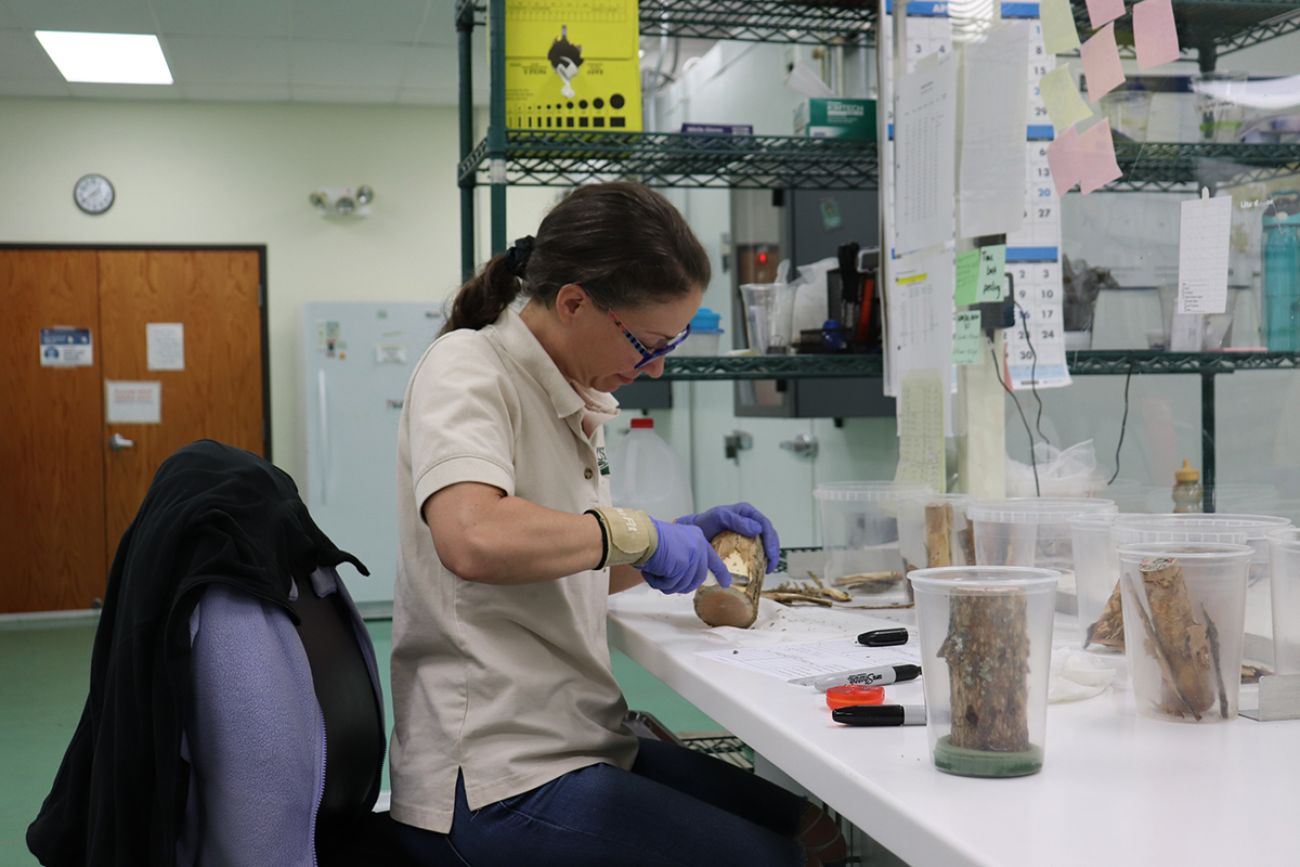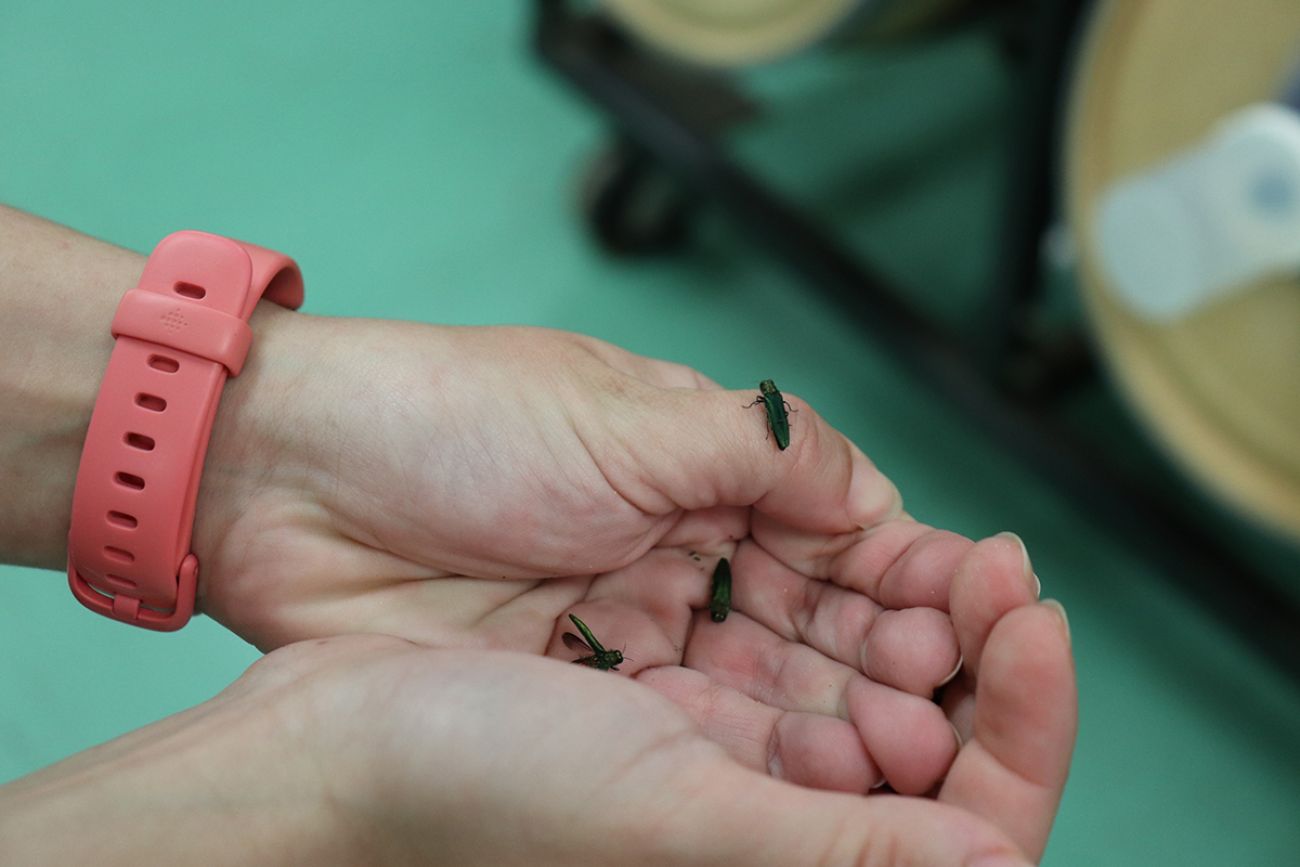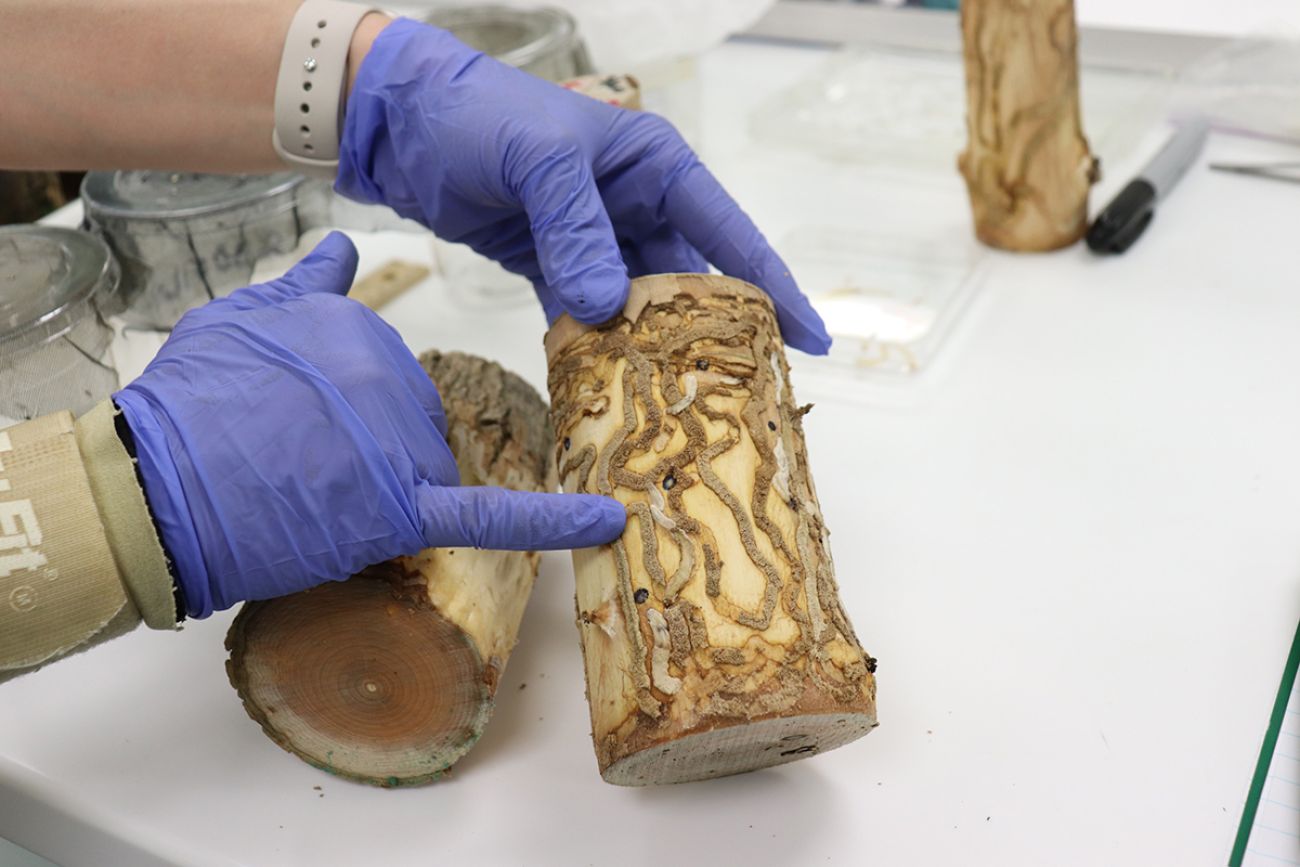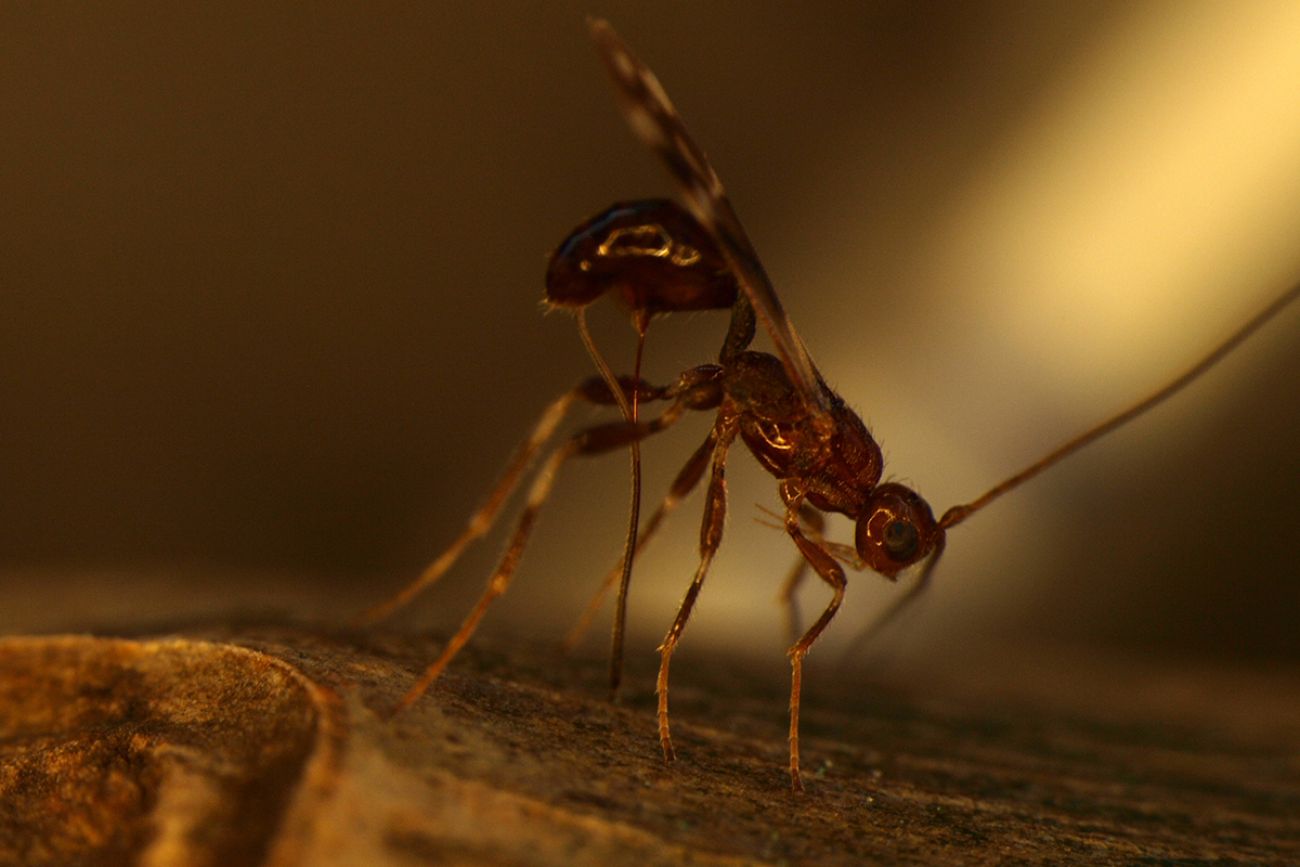Inside the Michigan lab where scientists raise killer bugs to save trees

- Emerald ash borer, one of Michigan’s most destructive invasive species, has killed over 40 million ash trees in the state
- A USDA lab in Brighton reproduces parasitoids, a natural predator native to Asia and Russia used for EAB biocontrol
- Parasitoids won’t completely eradicate EAB, so scientists are reproducing resistant ash tree species and insecticides
The squat, green-roofed office building just off the highway in Brighton doesn’t look like much, tucked away in an industrial park next to a dehumidifier company and machine shops.
But inside, scientists are hunched over lab tables, studying buzzing wasps that could be saviors for North America’s disappearing ash trees.
Staff members in the brightly lit lab room use cutting tools to edge away at the bark of ash tree logs. The larval insects are set in petri dishes on tray carts to the side and hundreds of tiny, murmuring wasps in clear plastic containers are stacked on silver trays bordering the walls.
Related:
- As northern Michigan warms, scientists bring tree seedlings from the south
- Armed with flea meds, Michigan defends hemlock trees against deadly invader
- Under current climate trends, Michigan’s Up North forests could be doomed
The enemy awaits in a humid room next door.
There, emerald ash borers (EAB) devour stacks of ash tree logs. The iridescent green beetles are among the most destructive invasive species in North America’s history.
EAB were first detected in Michigan about 20 years ago; scientists theorize they arrived as stowaways in wood packing material used to transport goods from Asia or Russia. Since then, the beetle has spread to 36 states and over 40 million ash trees in Michigan alone have come crashing down, according to the Arbor Day Foundation.
In this Brighton lab — the only one of its kind in the U.S. — scientists from the U.S. Department of Agriculture (USDA) are raising four species of stingless wasps native to Asia and Russia to release into the wild, where they hunt down and kill emerald ash borers. The wasps are emerald ash borer parasitoids, meaning their larvae feed on the beetle’s eggs and larvae, eventually killing them.

Since 2007, roughly 8 million of these wasps have been released around the country, said Nicole Sawallich, acting entomologist and supervisor of the USDA EAB control program.
In that time, they’ve shown early signs of controlling an EAB invasion that has swept across the country, with Michigan as its epicenter.
Ash trees were once one of the most abundant trees in Michigan, but in just two decades they’ve become endangered, impacting Michigan’s ecology, economy and Indigenous culture.
Ash trees are crucial for basket weaving in native tribes, and wood from ash trees is commonly used in furniture, timber, even baseball bats. Ash forests provide habitat for many species, and the trees’ fallen leaves help nourish other plants, said Deborah McCullough, a Michigan State University professor in the departments of entomology and forestry.
“Keeping those forests diverse with some of these natural species” allows the native ecosystem to continue, said James Wieferich, forest health unit manager at the Michigan Department of Natural Resources.
What makes EAB so destructive
A deceptively beautiful metallic green-winged beetle, female EAB lay eggs under the bark or in cracks of ash trees.
Within a few weeks, the larvae chew S-shape patterns, or galleries, through the bark toward the phloem, a tissue in the inner bark that transports nutrients between the leaves and roots. The larvae continue to feed into the xylem, a further inner tissue that carries water from roots up to the leaves.
As the larvae multiply they cut the tree’s ability to transport nutrients, its canopy grows thin, ultimately leading to the tree’s death, McCullough said.
Parasitoids to the rescue
Scientists at the USDA’s Forest Pests Methods Laboratory in Buzzards Bay, Massachusetts began initial research and foreign exploration in search of biological agents to control the spread of ash borers.
They discovered three species of wasp parasitoids in China and brought them back to the U.S. to study whether the wasps would work as intended without harming other species.
The parasitoids proved effective. Researchers discovered a fourth parasitoid in the Russia Far East and began releasing it in 2015.
The first release was in Michigan but there are now parasitoid release sites all over the Midwest, and stretching to Colorado and Louisiana.
The wasps hunt EAB by detecting the larvae vibrations under wood and depositing their eggs in or on EAB eggs and larvae, seemingly ignoring other types of insects. Scientists don’t actually know why parasitoids only target EAB, they just are glad it works.
The wasps are released from hanging pill bottles contraptions, called Oobinators , full of pupae parasitoids, placed in trees. They’re also shipped in ash wood bolts, or short logs, with a small hole drilled through the top for twine or zip ties to attach the log to a tree.

Are there alternative methods?
While scientists are working on propagating predators, they say it’s unlikely to be a silver bullet. Other approaches will be necessary to preserve what’s left of America’s ash trees, and scientists elsewhere are working on breeding disease-resistant trees to withstand EAB while the wasps contain the outbreak.
The USDA Forest Service’s Northern Research Station in Wisconsin first discovered a few “suspiciously healthy” ash trees among hundreds of EAB-infested trees that had fallen on the ground, said Rachel Kappler, forest health collaborator at Great Lakes Basin Forest Health Collaborative (GLB FHC).
Blue ash trees tend to be most tolerant, Weirich said, but green ash was most accessible to researchers and they learned the trees’ resistance trait is inheritable. They now have begun orchards of defiant young ash trees, Kappler said.
In partnership with MSU, the DNR has planted more than 600 ash trees in an orchard in Brighton, but it will take years until trees become big enough to reproduce seeds for restoration efforts, Wieferich said.
Combining wasp releases with non-toxic insecticide injections at the base of trees can also help control EAB, McCullough said.
What’s next?
According to the USDA Animal and Plant Health Inspection Service, as of 2022, parasitoids have been released in 31 states and have been found to be successfully reproducing and killing EAB, signs that the strategy is working.
But while wasps appear to be helping control infestations, they’re unlikely to fully eradicate EAB from North America.
“Biocontrol still has a long way to go,” said Sawallich, supervisor of the USDA EAB control program.

Spathius galinae is one of four tiny, stingless wasp species employed by scientists in the U.S. to control the spread of emerald ash borer. It has the added benefit of better tolerating colder climates. (Wikimedia Commons via USDA)
One of the first steps scientists took when EAB was first detected was to warn residents not to move firewood across the state, as that could allow invasive insects like EAB to spread beyond its natural range. Burning firewood locally is the best approach, Wieferich said.
The lab continues to search further in the Midwest and residents can watch a webinar from GLB FHC to learn how to identify and report a surviving ash tree for scientists to target with parasitoids.
The wasp-rearing program is expected to continue for the foreseeable future. The goal is to release enough to create a self-sustaining population, Sawallich said.
As wasps drive down EAB numbers, they should also begin to die off, Wieferich said. If and when that happens, Wieferich said the lab could foreseeably slow its work, too.
“The fact that these biocontrol agents are out in the field, they’ve shown to be established, they’ve shown to be able to disperse, and that they have the ability to control EAB populations is amazing,” said Ben Slager, senior entomologist of the USDA EAB control program. “What the program is accomplishing is phenomenal.”
Michigan Environment Watch
Michigan Environment Watch examines how public policy, industry, and other factors interact with the state’s trove of natural resources.
- See full coverage
- Subscribe
- Share tips and questions with Bridge environment reporter Kelly House
Michigan Environment Watch is made possible by generous financial support from:
Our generous Environment Watch underwriters encourage Bridge Michigan readers to also support civic journalism by becoming Bridge members. Please consider joining today.
See what new members are saying about why they donated to Bridge Michigan:
- “In order for this information to be accurate and unbiased it must be underwritten by its readers, not by special interests.” - Larry S.
- “Not many other media sources report on the topics Bridge does.” - Susan B.
- “Your journalism is outstanding and rare these days.” - Mark S.
If you want to ensure the future of nonpartisan, nonprofit Michigan journalism, please become a member today. You, too, will be asked why you donated and maybe we'll feature your quote next time!






